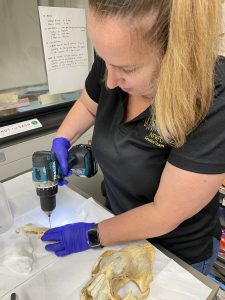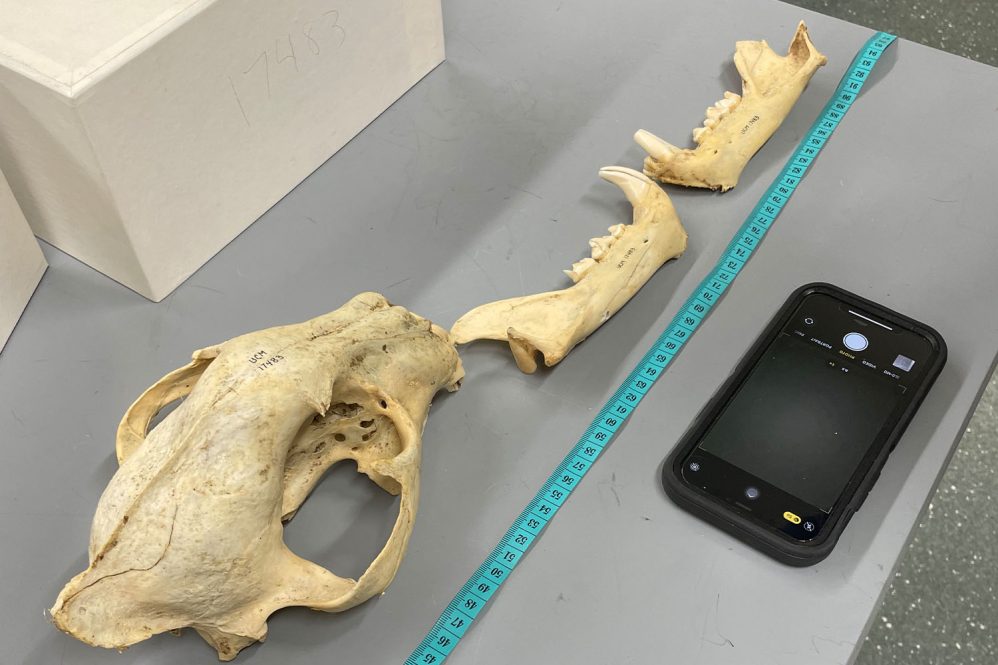Globally, species extinction rates are accelerating and reaching unprecedented levels. Unfortunately for many species, this means they also become more valuable for animal traffickers.
UConn Ecology and Evolutionary Biology Professor Eric Schultz explains that wildlife trafficking – which the Wildlife Conservation Society estimates is worth as much as $10 billion per year – is often connected with other international crimes such as the drug and weapons trades, because when networks exist, it is relatively easy to add another valuable commodity.
Non-governmental organizations and agencies, like the FBI, Department of Homeland Security, and U.S. Fish and Wildlife Service, work to stop these illegal trade networks, and the UConn Biodiversity Research Collections (BRC) is helping the effort.
The FWS is gathering data on how populations of trafficked species vary genetically to establish a database so confiscated specimens can be tested to locate where they may have been poached. One place where this detailed information is readily available is in research and museum collections.
Schultz says the FWS reached out because the UConn BRC contains jaguar bones collected in the Chaco region of Paraguay by UConn researchers in the 1960s.
“The jaguar skull collection here at UConn is special because of the collecting efforts of former faculty member Ralph Wetzel, who collected specimens in the Chaco region of Paraguay which is still relatively undeveloped,” says Schultz.

FWS scientists visited UConn and used small drills to gather samples of bone powder from the skulls. DNA extracted from that powder will be used to build cases against poachers and combat illegal animal trade.
Schultz explains that when a suspected violation of the Convention on International Trade in Endangered Species (CITES) is investigated, it is a criminal investigation.
UConn’s jaguar bone collection is both well-documented and well-preserved, which means the information FWS gathered from the samples will provide details to their growing database that will aid in CITES investigations.
“The Chaco samples represent another set of points on the map for them. Animals that live in different places can have a distinctive genetic fingerprint,” says Schultz. “The Chaco population is still in reasonably good shape, which means that genetics will not only be distinctive from other locations, but it also may be rich in genetic variability within and among individuals, enabling scientists to do additional analyses.”
DNA from confiscated specimens will be compared to information in the database to help trace, with a degree of certainty, the location where the animals were likely taken, says Schultz. Location data, like any information and clues that investigators can gather, bring to light valuable details about the networks and the people who operated within them.
The process of collecting genetic material from the specimen collection is straightforward, though somewhat destructive, Schultz explains. Roughly a teaspoon’s worth of bone powder is drilled away from an area of the skull that is unlikely to compromise future studies. In many cases, Schultz says, the samples can be collected from bone fragments that were morphologically non-informative. Then the samples are added to a solution of chemicals that extract and preserve the DNA.
“From our perspective, it’s great to have our material being used in ways that we hadn’t even thought about,” Schultz says. “This represents yet another case of something that we often say about our collections, which is that our material holds the answers to questions we haven’t even thought of. Our responsibility is to maintain these specimens in a condition where they can be used in a variety of ways. Now, this sampling in a sense was destructive, they’re taking material away from it that will not be reunited with the specimen, so we must permit those uses with caution.”
This collaboration also underscores the importance of making the research collections visible to a broader audience. Schultz guesses that the FWS became aware of the jaguar collection via an online repository called VertNet where BRC staff has digitized many of the mammals contained in the UConn collections.
“This is an important feature of our current and long-ongoing efforts to digitize our data, which involves going from handwritten notebooks to a spreadsheet. We’ve got a spreadsheet right now for our mammals, birds, amphibians, reptiles, and fish for separate kinds of collections. We’re always finding ways in which there are data gaps and data inaccuracies, but they’re mostly complete and accurate. Unlike mammals, the other databases have not been converted into a digital database that’s in publishable form, so it’s not searchable by others.”
Digitizing efforts are ongoing and for the amphibians, fish, and reptiles, Schultz says BRC has some unique material, but nobody outside of UConn knows it is there, and this signifies lost opportunities for others in the research community.
However, working with the FWS was a wonderful opportunity to collaborate and a reminder of the impact and importance of collections, Schultz says.
“The trick with collections is we’re dedicated to preserving these things for posterity to make sure the legacy is not lost. Projects like this spark the imagination. We hear stories like this regularly of something that was found in a museum that had been there all along, and people hadn’t realized it was there. Sure, we find things that we dig up out of the ground, and we realize their significance immediately, but as often as not, they’re found in a museum, and they’ve been there all along, but they need to be rediscovered.”



